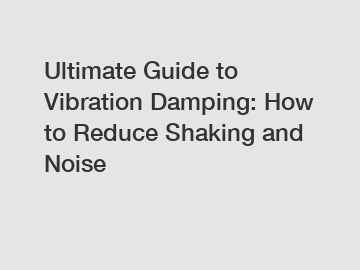Ultimate Guide to Vibration Damping: How to Reduce Shaking and Noise
Ultimate Guide to Vibration Damping: How to Reduce Shaking and Noise.
Vibration damping is a crucial aspect of many industries, from automotive to aerospace to construction. It is essential to reduce shaking and noise in various applications to ensure the safety, comfort, and performance of machinery and structures. In this ultimate guide, we will explore the different methods and techniques used to effectively damp vibrations, ultimately improving the overall operation and longevity of equipment.
One of the most common methods of vibration damping is the use of damping materials such as rubber or foam. These materials are often placed between vibrating components to absorb and dissipate the energy generated by the vibrations, thereby reducing the overall amplitude of the vibrations. This process is based on the principle of energy dissipation, where the damping material converts the kinetic energy of the vibrations into heat, effectively reducing the shaking and noise levels.

Another effective technique for vibration damping is the use of tuned mass dampers. These devices consist of a mass suspended on a spring and a damper, which are tuned to the natural frequency of the vibrating structure. When the structure vibrates, the tuned mass damper oscillates in opposition to the vibrations, effectively reducing the amplitude of the vibrations. This technique is commonly used in tall buildings, bridges, and other structures to reduce the effects of wind or seismic vibrations.
In addition to these methods, the design and layout of machinery and structures can also play a critical role in vibration damping. By optimizing the placement of components, adding additional supports, or modifying the structural design, engineers can effectively reduce the transmission of vibrations and mitigate noise levels. This approach is particularly important in industries where the performance and reliability of equipment are directly impacted by vibrations, such as in aerospace or precision manufacturing.
Overall, reducing shaking and noise levels through vibration damping has significant benefits for both the equipment and the environment. By minimizing vibrations, machinery and structures can operate more efficiently, experience less wear and tear, and have an extended lifespan. Additionally, lower noise levels contribute to a safer and more comfortable working environment for operators and nearby residents. As such, investing in vibration damping techniques is essential for enhancing the reliability, performance, and sustainability of various applications across different industries.
If you want to learn more, please visit our website china opgw suspension clamp, downlead, custom adss suspension clamp.
149
0
0


Comments
All Comments (0)